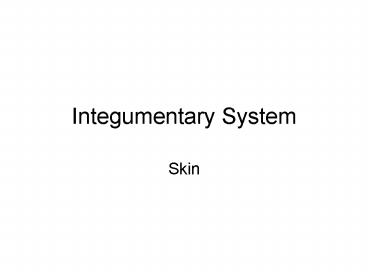Integumentary System - PowerPoint PPT Presentation
1 / 24
Title:
Integumentary System
Description:
... skin, especially in thick skin = finger prints, etc. Palmar and Plantar surfaces ... Occur over entire body except palmar and plantar surfaces, lips, external ... – PowerPoint PPT presentation
Number of Views:147
Avg rating:3.0/5.0
Title: Integumentary System
1
Integumentary System
- Skin
2
Integument
- Important organ represents 15 of total body
weight. - Functions
- a) protection (mechanical barrier)
- b) detective organ (receptors)
- c) antiseptic barrier (chemical barrier)
- d) thermoregulation
- e) secretion and absorption
- f) Vitamin D synthesis
3
Integument
- Two Layers
- a) epidermis (ectodermal)
- b) dermis (mesodermal)
- Hypodermis - below dermis, attaches skin to body
not part of the skin.
4
Integument
- Boundary between epidermis and dermis marked by
prominent papillations dermal papilla. - These folds manifest themselves on the surface of
the skin, especially in thick skin finger
prints, etc. Palmar and Plantar surfaces
5
Integument
- Epidermis most cells from superficial ectoderm
(keratinocytes). - Pigment cells in basal layer from neural ectoderm
(melanocytes). Pigment cells form melanin. - Skin color due to
- a) carotene - yellow pigment in all cells
- b) blood vessels in underlying dermis
- c) melanin pigment in melanocytes at basal
layer of epidermis.
6
Integument
- Epidermal cells undergo keratinization as they
move from the basal surface to the free surface
keratin or its intermediate protein replaces cell
cytoplasm causing cell death. - Cells become progressively flattened as they move
to the surface. - Langerhans Cell antigen presenting cell of
epidermis, mainly in stratum spinosum. - Merkel's Cell - disc - tactile receptor in
epidermis.
7
Thin Skin
8
Epidermis
- Epidermis composed of five layers
- a) stratum corneum
- b) stratum lucidum
- c) stratum granulosum
- d) stratum spinosum
- e) stratum germinativum (basale)
9
Epidermis
- Stratum Corneum - outermost layer of skin clear,
dead, flat, scale-like cells fused together.
Cytoplasm completely replaced by keratin. Cells
constantly sloughed off. - Stratum Lucidum - thin, clear, translucent layer.
Cells flat and closely packed. Cytoplasm
contains keratohyalin, a precursor product of
keratin. Also contains eleiden, a refractile
substance related to keratohyalin. Produces the
clear nature of these cells.
10
Skin Sensorial Receptors
11
Epidermis
- Stratum Granulosum - thin, darkly pigmented layer
of cells, 3-5 cell layers thick. Nuclei present
in these cells tonofilaments present and
keratohyalin (granules). Cells flatten and die
in this layer. - Stratum Spinosum - cells polyhedral (cuboidal)
with spaces between each. Surfaces of cells with
desmosomes. Many tonofibrils. Keratinization
begins here. Sometimes included with str. germ.
as Stratum Malpighii.
12
Stratum Spinosum
13
Epidermis
- Stratum Germinativum (basale) - single layer of
cuboidal cells have attachment process on basal
surface attaching epidermis (hemidesmosome) to
basement membrane (outer dermis). - Cells divide and move toward the surface. -
melanocytes (derived from neural crest) are below
and send cytoplasmic processes up between
germinativum cells.
14
(No Transcript)
15
(No Transcript)
16
Dermis
- Papillary Dermis - outer layer, reticular fibers
on outer surface contribute to lamina anchoring
the epidermis. Small fibers and more cells
(fibroblasts and macrophages) present. Some fat
may be present, pigment cells may occur in areola
and anal ring. - Reticular Dermis - inner layer strongly fibroid
relatively acellular. Fibers long and orient in
layers Langer's Lines. Thickest layer hair
follicles, smooth muscle and some fat present.
17
Integument
- Skin Products
- 1) Nails - formed by infolding of skin layers.
Nail bed formed by deeper layers of epidermis (s.
spinosum and s. basale). Outer epidermal layers,
corneum and lucidum, have high sulfur content and
form nail proper. Pink color due to underlying
blood vessels. Corneum forms epinychium
(cuticle) and hyponychium
18
(No Transcript)
19
Integument
- 2) Hair - keratinized threads composed of free
shaft and root. Occur over entire body except
palmar and plantar surfaces, lips, external
genitalia and anal apertures. - Hair root embedded in a follicle of mostly
epidermis and dermis.
20
- Hair Shaft
- a) medulla - shrunken, cornified cuboidal cells
with air spaces between absent in blond hair
contains pigment and soft keratin. - b) cortex - forms bulk of hair long cornified
cells of hard keratin. Pigment between and
within cells. - c) hair cuticle - outer cornified cells with no
nucleus.
21
- Hair Follicle epidermal components
- internal epithelial sheath modified corneum
- 1) follicle cuticle - cornified outer layer of
cells facing hair shaft cuticle. - 2) Huxley's Layer - multiple layers of
squamoid cells with tricohyalin. - 3) Henle's Layer - 1 cell thick, clear cells
(squamous) with hyalin.
22
- b) external epith. sheath modified str.
spinosumDermal components dermal papilla,
provides blood vascular supply to hair follicle. - Sebaceous Glands and smooth muscle attach to
hair follicle. Muscle Arrector pilae, produces
cutis anserina (goose flesh). - 3) Sweat Glands - located deep in the dermis
and/or hypodermis.
23
Sebaceous Gland
- Acinar gland opens to short duct into upper hair
follicle - Differentiate from epithelial stem cells (arrow).
- Accumulate lipid droplets
- Droplets fuse, cell bursts (holocrine)
- Sebum- TGs, waxes, cholesterol, squalene
- Begin to function at puberty
24
Sweat Glands
- Simple coiled tubular gland under Autonomic
Control - Secretory gland in dermis, duct through epidermis
to surface - Stratified cuboidal epith.
- Merocrine- hypoosmotic, NaCl, urea, ammonia
- Apocrine- axial, anal, areolar larger gland
duct opens to hair follicle. - Odor with bacterial degrad.































